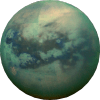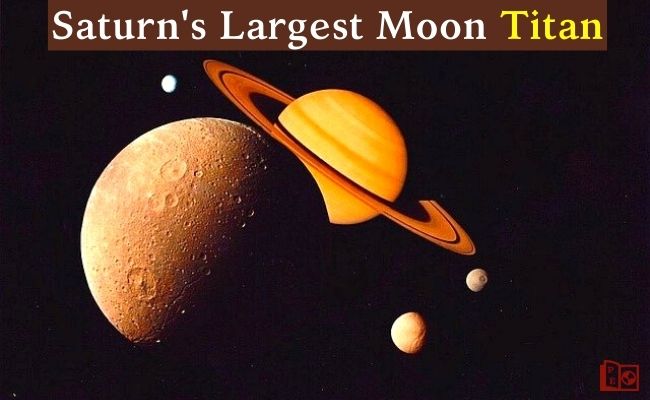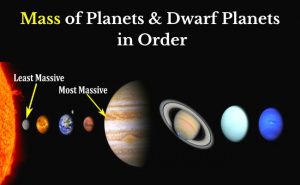Titan is the largest Saturn moon. It is also the second-largest moon in our solar system after Jupiter’s satellite Ganymede. One of the interesting Titan moon facts is, it is even larger than Planet Mercury.
After the discovery of the four Galilean satellites of Jupiter in 1610, scientists started to discover other planet’s natural satellites. Then they found Titan and it became the sixth known planetary moon (after 4 Galilean Moons and 1 our Earth’s Moon). It was the first known moon of Saturn Planet and was discovered by Dutch astronomer “Christiaan Huygens” in 1655.
Top 10 Titan Moon Facts
Here in this article, we have mentioned the top 10 interesting facts of Titan that may surprise you knowing after.
1. Largest Saturn Moon
It is the largest moon of planet Saturn. If it were not orbiting Saturn, it would have been considered a Planet. The size of the Titan according to the average diameter is around 5150 km. And this is around 0.4 times Earth’s diameter. It is the second-largest moon in our solar system after Jupiter’s moon Ganymede.
2. Bigger than Planet Mercury and Earth’s Moon
The second-largest moon Titan is even bigger than Planet Mercury and our Earth’s moon. The average diameter of Titan is almost 5150 km.
Whereas the average diameter of Mercury is 4880 km and the diameter of our Moon is almost 3474 km. It is almost 5% larger than Mercury but 50% bigger than our Moon. Due to its bigger size, it is referred to as a planet-like moon.
3. It is a cold world
The average distance of Saturn is around 1434 million kilometers or 9.6 AU from the sun. And Titan orbit planet Saturn with an average distance of 1.2 million km. So it is very far from the sun.
Titan receives very little sunlight, almost 1% of Earth. But due to its dense atmosphere than the earth, 90% of sunlight absorbed by its thick atmosphere. So only 0.1% of sunlight reaches its surface compared to earth. And thus the average temperature of this cold world is almost −180°C or 94K.
4. Titan has lakes and seas on the surface
Saturn’s Largest Moon Titan is the only body in space except for our earth where scientists have found evidence of surface liquid. And this is one of the best and informative facts about the Titan Satellite. There is a possibility of hydrocarbon seas and lakes according to data collected by space probes Pioneer 11, Voyager 1 and 2, and Cassini–Huygens.
Taken images and data by the above spacecraft especially by Huygen Lander, scientists announced there is evidence of lakes filled with methane and ethane (hydrocarbons). Most scientists believed these lakes and seas are in form of hard-ice but beneath them, there could be liquid oceans. Some evidence also concludes few drainage networks connected to hydrocarbon seas present on it.
5. It is a tidally locked moon
Like most of the moons of the solar system, Titan is also a tidally locked moon. A tidally locked moon’s revolution period is almost the same as the orbital period, so it always has the same face toward its planet.
It takes almost 15 days 22 hours to complete one orbital rotation around its planet Saturn and same time for revolving around its own axis. And thus one day and one year on this world take 15 days and 22 hours of earth.
6. The only known moon to have a dense atmosphere
It is the only known moon in our solar system that has quite enough and dense atmosphere with a nitrogen-rich atmosphere. The atmospheric composition of Titan is:
- Nitrogen – 97%
- Methane – 2.7%
- Hydrogen – 0.15%
and rest are other gases.
According to data, its atmosphere is denser than our Earth with a surface pressure of almost 1.45 atm. And this is the only moon in our solar system that has some high atmospheric pressure even denser than our earth.
Below is the image of Titan moon atmosphere and surface taken by the Cassini spacecraft in the infrared view.

7. You can easily fly on Titan
The surface gravity of the Largest moon of Saturn Titan is almost 1.35 m/sec2. That is almost 0.138 times of the earth. With this low gravity and high atmospheric pressure, anyone can easily fly in its atmosphere with just the help of a pair of small wings.
8. No moons, no rings, no magnetic field
Where a large and massive object of space can own a moon as well as the ring. But Titan does not have any moon or ring around it. It also has no magnetosphere present on it.
9. Chances of the existence of life
It is one of the best Titan moon facts that life can exist on it. Though its surface may be a cold world and beneath its icy cells there could be liquid oceans. That could be a suitable condition for microbial life.
Life can arise on it due to its atmosphere with help of simple organic compounds. Where our earth has only 78% of nitrogen gas in its atmosphere and here Titan moon has 97%. As we know Nitrogen is essential for survival and growth for living things, so this place can lead life.
Even many scientists believe Titan is more suitable and habitable for life than planet Mars. Though the available hydrocarbon lakes and atmosphere can cause different types of lives that we can not recognize yet. And many scientists also believe, due to low sunlight life could not be there. But in the future when our sun will become a red giant then it can support life easily.
10. Most distant landing by any space probe
Cassini-Huygens mission was launched on 15 October 1997 by joint collaboration of NASA, the European Space Agency (ESA), and the Italian Space Agency (ASI). It was sent to study the planet Saturn and its system.
Cassini was a space probe that orbited Saturn for almost 13 years. Whereas Huygens was a lander that landed on the Titan’s surface on 14 January 2005 at a region called Adiri. The landing on Titan is the most distant landing so far on any celestial object in human history.
So these were the top 10 Titan Moon Facts, largest of Saturn. Some other relevant and informative information is given below about Satellite Titan in form of questions, hope you will like that too.
Frequently Asked Questions about Titan Satellite
What is the average temperature on Titan?
The average temperate in this cold world is around 94K (−180°C). It is one of the farthest satellite that is why less sunlight reaches on its surface. Approximately 0.1% of sunlight reaches its surface compared to our Earth.
Does Titan Moon have Oxygen?
There is no solid evidence of Oxygen has been found on Titan Satellite. But some scientists believe in a hypothetical cell membrane that can function in liquid methane or in frigid temperature. And they are composed of phospholipids, compounds of carbon, oxygen, hydrogen, and phosphorus.
What is the Titan’s distance from Earth?
The average distance of Saturn from the Sun is 9.6 Astronomical Unit (AU). One AU is the distance between Sun and Earth. The closest and farthest distance of Saturn from the Earth is around 1200 million km (8 AU) to 1700 million km (11 AU) respectively. And as we know the Titan’s distance from Saturn is almost 1.2 million km. So it doesn’t affect too much distance while rounding off Titan’s distance from the earth.
Reference:- https://en.wikipedia.org/wiki/Titan_(moon)
- 5 Best Solar System Backpacks in 2024
- Mass of Planets in Order from Lightest to Heaviest
- Star Projector {2024}: Star Night Light Projector




